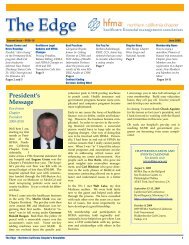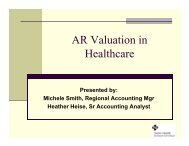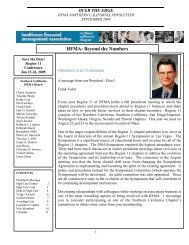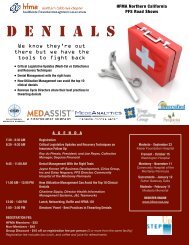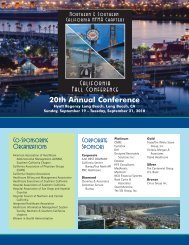Chargemaster Nuts and Bolts
Chargemaster Nuts and Bolts - Hfma-nca.org
Chargemaster Nuts and Bolts - Hfma-nca.org
Create successful ePaper yourself
Turn your PDF publications into a flip-book with our unique Google optimized e-Paper software.
<strong>Chargemaster</strong> <strong>Nuts</strong> <strong>and</strong> <strong>Bolts</strong><br />
By Cathy Meeter, R.N. BSN<br />
CMAS<br />
CDM Director, Sutter Health
Disclaimer<br />
The comments expressed throughout this<br />
presentation are my opinions, predicated<br />
on my interpretation of regulations/<br />
guidelines <strong>and</strong> my experiences.
Objectives<br />
1. Define Charge Description Master (CDM) <strong>and</strong><br />
its primary data elements.<br />
2. Discuss the importance of the CDM in the<br />
Revenue Cycle.<br />
3. Delineate who ‘owns’ the CDM <strong>and</strong> scope of<br />
responsibility.<br />
4. Discuss the variability among payer billing<br />
guidelines.<br />
5. Discuss key areas that should be reviewed.
What is a Charge Description<br />
Master?<br />
The Charge Description Master (CDM) is<br />
primarily a list of services/procedures,<br />
room accommodations, supplies,<br />
drugs/biologics, <strong>and</strong>/or<br />
radiopharmaceuticals that may be billed to<br />
a patient registered as an inpatient or<br />
outpatient on a claim.
What is a Charge Description<br />
Master ( (continued)<br />
• The core group of data elements that<br />
typically resides within a CDM are:<br />
-CDM number s -Charge amounts<br />
-Revenue codes -Department numbers<br />
-GL numbers -Modifiers (hard coded)<br />
-CPT/HCPCS codes<br />
-Billing <strong>and</strong>/or charge descriptions
What is a Charge Description<br />
Master ( (continued)<br />
• CDM number = unique identifier number<br />
assigned to a given line item in the CDM.<br />
• Revenue code – a four digit numeric code<br />
established by the National Uniform Billing<br />
Committee (NUBC) that categorizes/classifies a<br />
line item in the CDM.<br />
• GL (General Ledger) number = a number used<br />
for accounting purposes that directs the revenue<br />
to the appropriate department.
What is a Charge Description<br />
Master ( (continued)<br />
• CPT/HCPCS code<br />
– Current Procedural Terminology (CPT) codes are<br />
maintained by the American Medical Association<br />
(AMA). These codes describe services, procedures<br />
<strong>and</strong> drugs. They are updated in January <strong>and</strong> July of<br />
each year.<br />
– Healthcare Common Procedure Coding System<br />
(HCPCS) is maintained by the Centers for Medicare<br />
<strong>and</strong> Medicaid (CMS). These codes describe<br />
services, procedures, durable medical equipment<br />
(DME), supplies, drugs, biologics, <strong>and</strong><br />
radiopharmaceuticals. They are updated continually<br />
throughout the year.
What is a Charge Description<br />
Master ( (continued)<br />
• Billing description = the description that appears<br />
on a patient claim. There may be an additional<br />
field in the patient accounting system for a<br />
charge description. Charge descriptions may<br />
have a longer string of characters <strong>and</strong> may be<br />
used for order entry. They should mean the<br />
same as the billing description.<br />
• Charge amount = the dollar amount assigned to<br />
a CDM line item which will appear on a claim.
What is a Charge Description<br />
Master ( (continued)<br />
• Department number = a number assigned to a particular<br />
department that denotes the area.<br />
• Modifier – a two digit alpha or numeric character that can<br />
be appended to a particular CPT or HCPCS code to<br />
provide additional information about that code.<br />
– Hard coded modifiers can be placed into the CDM <strong>and</strong> will<br />
always be appended to the CPT/HCPCS code for that line item.<br />
Examples are the therapy modifiers of GO, GN, GP.<br />
– Soft coded modifiers should be appended to a CPT/HCPCS<br />
code predicated upon review of the medical record. Examples<br />
are modifier 59 (distinct service) <strong>and</strong> 52 (reduced service).
What is a Charge Description<br />
Master (continued)<br />
• The CDM may also contain/be used for the<br />
following:<br />
– Statistical tracking line items.<br />
• Used to capture labor for budgetary purposes.<br />
• No dollars, CPT/HCPCS or revenue code attached.<br />
– Payment <strong>and</strong> adjustment codes.<br />
– Database.<br />
• For financial, managed care <strong>and</strong> other analysis.<br />
• For submission to OSHPD.<br />
– Private pay services.<br />
– Other.
How Important is the CDM?<br />
• The CDM is integral to a hospital’s<br />
revenue cycle.<br />
–It is the ‘backbone’ of reimbursement<br />
providing many of the necessary<br />
data elements for compliant claims<br />
submission.<br />
–AR days can be maximized with<br />
accurate CDM data.<br />
• Decrease/eliminate edits.
Who Owns the CDM?<br />
• It is recommended that a team approach be<br />
taken to ‘manage’ the CDM with participants<br />
including but not limited to:<br />
– Billing/Business Office/Patient Financial Services.<br />
– Health Information Management.<br />
– Managed Care.<br />
– Compliance.<br />
–IT.<br />
– Department managers/directors from the various<br />
service areas that generate charges.<br />
– Physicians who are responsible for creating <strong>and</strong><br />
reviewing medical protocols (ad hoc).
CDM Team Responsibilities<br />
• Keep abreast of new/changing regulatory/<br />
contractual issues.<br />
• Assess how the new/changing<br />
regulatory/contractual issues impact the CDM.<br />
• Implement necessary updates/changes to the<br />
CDM, order entry feeder systems, charge<br />
tickets, interfaces <strong>and</strong> educate appropriate staff.<br />
• Evaluate/reassess updates/changes.<br />
• Develop policies <strong>and</strong> procedures.
Variable Payer Guidelines<br />
• The choices are:<br />
– Charge <strong>and</strong> bill all payers the same or<br />
– Charge <strong>and</strong> bill non-governmental payers for those<br />
services deemed non-billable to Medicare.<br />
• If you choose the latter option, it is highly recommended that<br />
you engage legal counsel to research any potentially adverse<br />
impact from this decision in terms of Cost Reporting<br />
(determining ratio of beneficiary charges to total charges,<br />
issues with apportionment, etc.) <strong>and</strong> contractual language<br />
with non-governmental payers.
Beyond the <strong>Chargemaster</strong> Flat File<br />
• An accurate, up to date chargemaster in<br />
<strong>and</strong> of itself does not guarantee accurate<br />
claims submission. It is only a beginning<br />
point.<br />
• There are many issues associated with<br />
creating, maintaining <strong>and</strong> utilizing a CDM.<br />
The following slides will list areas you<br />
should consider reviewing at your facility.
CDM Line Item Size<br />
• Reduce the size of your CDM by<br />
periodically removing zero volume/zero<br />
revenue line items.<br />
– Before inactivating a line item, obtain<br />
approval from the department first in case<br />
the item was recently added or is used<br />
infrequently.
Supplies<br />
• Eliminate routine (not billable) supplies<br />
<strong>and</strong> equipment <strong>and</strong> bundle the cost into<br />
the daily R & B or procedure charge.<br />
• Ensure that all non-routine, billable<br />
supplies are classified under the<br />
appropriate revenue code.<br />
– This may have reimbursement implications if<br />
you have ‘carve outs’ specified in your<br />
commercial payer contracts.
Supplies (continued)<br />
• Apply HCPCS codes where appropriate on<br />
outpatient claims.<br />
– Medicare will pay for certain outpatient supplies via<br />
DMEPOS fee schedule or as a pass- through.<br />
– Know the rules regarding use of supply HCPCS<br />
codes! Examples are:<br />
• Take home surgical dressings cannot be billed on the day of<br />
surgery.<br />
• Patients must meet the condition of permanence to bill<br />
certain items as a prosthetic.<br />
– You may have contractual language that specifies the<br />
need for submitting HCPCS codes for commercial<br />
payers.
Supplies (continued)<br />
• Criteria to bill a supply:<br />
– Medically necessary.<br />
– Single patient use, disposable <strong>and</strong> represents a cost.<br />
– Ordered by a physician (as a specific supply or as a<br />
procedure) or via an approved hospital protocol.<br />
– Documented in the medical record or other source<br />
that can easily be retrieved to validate that a supply<br />
item was used on a particular patient.
Supplies (continued)<br />
• Ensure that supplies that are opened but<br />
not used are not billed.<br />
• Ensure that supplies contaminated by staff<br />
are not billed.<br />
• Stay current with the Medicare Device to<br />
Procedure <strong>and</strong> Procedure to Device edits.<br />
• Discourage the use of ‘miscellaneous’<br />
supply item descriptors.
Supplies (continued)<br />
• Bill separately for each non-routine, billable<br />
supply for the following reasons:<br />
– Records are typically not kept of what supply items<br />
are built into a procedure. Over time, people may<br />
begin to charge separately for the supplies built into<br />
the procedure without removing their cost from the<br />
procedure charge.<br />
– Supply costs may fluctuate which would not allow for<br />
easy recalculation of the charge into the procedure.<br />
– You provide data to Medicare of supplies used with<br />
the procedures billed. They use this data to weigh<br />
future payments for APCs <strong>and</strong> DRGs.
Drugs/Biologics/Radiopharms<br />
• Create CDM line items with CPT/HCPCS<br />
codes (where they exist) with the<br />
appropriate billing unit.<br />
• Ensure the amount administered to the<br />
patient gets converted into the appropriate<br />
billing units.<br />
• Hemophilia clotting factors will be paid<br />
beyond the DRG if reported with the<br />
HCPCS code under revenue code 0636.
Drugs/Biologics/Radiopharms<br />
• Single use vials<br />
(continued)<br />
– May bill for the entire amount of a single use<br />
vial if only part of the vial is administered to an<br />
outpatient <strong>and</strong> there is no other patient to<br />
which the drug can be administered.<br />
– Should document the amount administered to<br />
the patient <strong>and</strong> the amount wasted in the<br />
medical record.
Observation<br />
• Purpose is to allow the physician time to make a<br />
determination as to whether the patient should<br />
be admitted as an inpatient or discharged home.<br />
• Bill by the hour using G0378.<br />
• Can charge for direct admit using G0379.<br />
• Physician must document use of risk<br />
stratification criteria to support that the patient<br />
would benefit from Observation care.
Observation (continued)<br />
• Patients cannot be pre-admitted into an<br />
Observation status.<br />
• Patients cannot be ordered into<br />
Observation status upon their entrance<br />
into the PACU (Post Anesthesia Care<br />
Unit). They must develop a complication in<br />
the normal PACU time (typically 4-6 hours)<br />
that warrants Observation status.
Observation (continued)<br />
• A specific physician order should be<br />
written as “Admit to Observation.” No other<br />
verbiage is acceptable.<br />
• Orders written as “Admit to Short Stay”<br />
<strong>and</strong> “Admit to 23 Hours” are unacceptable.
Observation (continued)<br />
• Inpatient admissions typically cannot be<br />
converted to Observation.<br />
– Condition code 44 = inpatient admission changed to<br />
outpatient.<br />
– Change must be made prior to discharge.<br />
– Hospital has not submitted a claim to Medicare.<br />
– A physician concurs with the UR Committee’s<br />
decision.<br />
– The physician’s concurrence is documented in the<br />
patient’s medical record.
Observation (continued)<br />
• Bill for all services rendered to Observation<br />
patients. Common procedures are:<br />
– Infusions<br />
– Injections<br />
– Transfusions<br />
• Billing for infusions <strong>and</strong> injections administered<br />
to an Observation patient must take into account<br />
charges generated for these services in the ED.
Interventional Radiology<br />
• Most interventional radiology procedures<br />
do not have a single CPT/HCPCS code to<br />
describe the procedure.<br />
• Ensure that the appropriate surgical<br />
component codes are billed in conjunction<br />
with the radiology CPT code(s).
Evaluation <strong>and</strong> Management<br />
(E & M) Codes<br />
• E & M codes were created by physicians for<br />
physicians. Most of the E & M definitions in the<br />
CPT book are not applicable to hospitals. Critical<br />
care is the exception (CPT 99291/99292).<br />
• Hospitals may use E & M codes but must create<br />
their own objective criteria that reflects resource<br />
consumption that is not otherwise represented<br />
by another CPT or HCPCS code.
Evaluation <strong>and</strong> Management<br />
(E & M) Codes (continued)<br />
• The objective criteria should be documented,<br />
available <strong>and</strong> uniformly applied. Periodic reviews<br />
should be conducted to determine if the<br />
appropriate E & M code was assigned.<br />
• Definitions for hospitals:<br />
– New patient = patient does not have a medical record.<br />
– Established patient = patient has a medical record.
Infusions <strong>and</strong> Injections<br />
• The AMA has created many new codes with new<br />
<strong>and</strong> confusing concepts/rules over the past<br />
several years, i.e. initial, subsequent, sequential,<br />
etc.<br />
• Hierarchy for billing:<br />
– Chemotherapy infusions<br />
– Chemotherapy injections<br />
– Therapeutic infusions<br />
– Therapeutic injections<br />
–Hydration
Infusions <strong>and</strong> Injections (continued)<br />
• Only one initial service charge should be<br />
generated unless the patient has another<br />
vascular access site.<br />
• The initial service code applied to the<br />
claim does not have to be the initial<br />
service provided to the patient.
Infusions <strong>and</strong> Injections (continued)<br />
• A new code was created in 2008 for<br />
hospitals (only) to allow charging for IV<br />
pushes of the same drug where more than<br />
30 minutes has elapsed.<br />
• For those IV pushes where less than 30<br />
minutes has elapsed, I recommend<br />
building each IV push into an E & M code<br />
where appropriate, i.e. ED codes,<br />
outpatient E & M codes.
Infusions <strong>and</strong> Injections (continued)<br />
• Options for generating charges:<br />
– Educate staff in all areas that bill for infusion<br />
<strong>and</strong> injection services.<br />
– Create ‘chart checkers’ or ‘super users’ in<br />
areas that bill for infusion <strong>and</strong> injection<br />
services.<br />
– Have the HIM Department generate the<br />
charges or validate the charges that are<br />
generated.
Dialysis<br />
• Hospitals that do not have a certified<br />
ESRD maintenance facility, can bill for<br />
ESRD patients who present to their<br />
hospital for emergency treatment <strong>and</strong><br />
subsequently receive their dialysis<br />
treatment while registered as an<br />
outpatient.<br />
• Bill for the dialysis service using G0257.
Emergency Room<br />
• Type B emergency departments<br />
– Not open 24 hours a day, seven days a week.<br />
– Use HCPCS codes (G0380-G0384) <strong>and</strong> not<br />
the CPT codes (99281-99285).<br />
• Fast Track areas in the ED should be<br />
reviewed to see if they fall into a Type B<br />
classification.
Emergency Department (continued)<br />
• Critical care<br />
– CMS recently published a Q <strong>and</strong> A on their website<br />
stating that the procedures listed in the CPT book<br />
(narrative section) that are considered included in the<br />
code for physicians are applicable as well to<br />
hospitals.<br />
– The edits for these codes for hospitals were removed<br />
in 2003.<br />
– CMS states that hospitals should not bill for these<br />
services along with critical care even though there are<br />
no edits.
Education<br />
• Ongoing education is key to having staff remain<br />
current with information necessary to<br />
appropriately bill for services rendered.<br />
• Code changes <strong>and</strong> description changes must be<br />
communicated to the departments who will be<br />
generating the charges.<br />
• Code changes <strong>and</strong> description changes may<br />
need to be altered in/added to the feeder system<br />
or the charge ticket may need to be updated.
Final Comments<br />
• The CDM is more than a flat file.<br />
• Collaboration is required with many<br />
departments to maintain the CDM, feeder<br />
systems, <strong>and</strong> charge tickets to be able to<br />
generate appropriate, compliant claims.<br />
• Ongoing education is vital.<br />
• Senior management support is necessary<br />
in creating a culture of accountability.
Wrap Up<br />
Questions?



